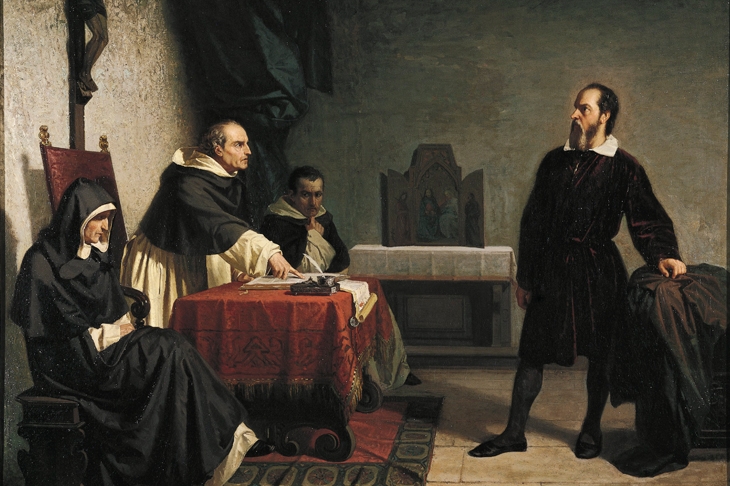If you go to the Campo dei Fiori in Rome on 17 February every year, you’ll find yourself surrounded by an eclectic crowd of atheists, free-thinkers, Catholic reformers, anarchists, mystics, students, scientists and poets all jostling to lay tributes before the statue of the hooded Dominican friar whose shadowed face stares inscrutably towards the Vatican. His name is Giordano Bruno and his statue, erected by public subscription in the 19th century, commemorates the site where he was burned for heresy in 1600 at the hands of the Roman Inquisition.
In the four centuries since, the idea of martyrdom has attached to Bruno’s death, with various causes (including, recently, a member of the Russian protest group Pussy Riot) claiming him as a symbol of intellectual courage and free thought in the face of repressive authority. Because a number of the charges brought against him at his trials involved his repeated support for the heliocentrism of Copernicus and a belief in the possibility of an infinite universe, he has often been hailed — spuriously — as the first martyr for modern science. In 2014, the Fox TV series Cosmos: A Spacetime Odyssey dedicated much of its first episode to a simplified version of Bruno’s life, emphasising his cosmology; and in the same year Professor Brian Cox referred to Bruno’s ‘cinematic death’ in Human Universe — though he acknowledged that Bruno was ‘more belligerent free-thinker than proto-scientist’.
Though Bruno’s scientific ideas were sketchy at best, and he was as much interested in ancient magic and philosophy as he was in observational astronomy, his theories were picked up and developed by later thinkers, including Kepler and Galileo, and in many ways his reputation has been eclipsed by theirs. Now a new study by Alberto A. Martínez, Professor of History of Science at the University of Texas, attempts to compare the trials of Bruno and Galileo, 33 years apart, and establish why the latter survived, to become a familiar name in the history of scientific thought, while Bruno was condemned and his work suppressed.
‘For more than 100 years, people have wondered whether the infamous trial of Galileo was connected to the Inquisition’s previous trial against Bruno,’ Martínez writes. ‘This book will show that these trials were indeed linked.’ This is hardly a groundbreaking revelation; the link has always been evident in the person of Cardinal Robert Bellarmine, the Jesuit inquisitor who interrogated and sentenced Bruno and who later ordered Galileo to abandon his heliocentric theories.
The difficulty in drawing direct parallels between the two is that our knowledge of Bruno’s trials is only partial; the surviving decree of his sentence mentions eight separate charges of heresy which he refused to abjure, but the original records of his final, Roman trial have been lost, and so the details of those heretical propositions have been a matter of speculation and extrapolation.
Martínez’s principal proposition is that Bruno’s heresies were deeply offensive to the Holy Office because they echoed the so-called Pythagorean doctrines, which included the belief that the Earth moves because it is animated by a soul, and that Galileo’s writings drew on the same ideas. He outlines the charges against Bruno and proceeds to examine each one forensically, comparing them with similar references in classical texts, Bruno’s own books and the writings of the Church Fathers to support his Pythagorean thesis. The level of detail here is so exhaustive that even the most ardent Bruno aficionados might struggle to stay engaged through the first chapter, but the bigger difficulty is that Martínez has a tin ear for prose style and often sounds as if he’s writing a GCSE essay, his sentences liberally peppered with ‘furthermore’, ‘for example’ and ‘hence…’
Bruno’s peripatetic life in exile was full of drama — one of the reasons I appropriated him as the spy-hero of my series of historical novels — and Galileo’s was likewise rich in incident, so it’s some kind of achievement to have made a book about both men quite so dry. But it’s not without moments of interest; Martínez includes recently discovered documents, among them a contemporary account by a Roman notary of Bruno’s execution with, most movingly, a marginal sketch of Bruno on the pyre, the only known drawing of him made in his lifetime.
Outside academic circles, the exact nature of Bruno’s contribution to the history of Western thought is probably of less interest to modern readers than his life story, and the courage with which he defended those ideas to the death; even Martínez acknowledges this in his Conclusion, where he hails Bruno as ‘a martyr for freedom of thought’. Burned Alive will no doubt find a place among academic studies of Bruno’s influence, though it would be fairly impenetrable to a general audience, which is a shame. As Martínez points out, his story deserves to be better known.






Comments